In all 50 states and around the world, Campaign Nonviolence has been building a culture of active nonviolence, free from war, poverty, racism, and environmental destruction. We share skills and tools with which people can practice nonviolence toward themselves, one another, and the Earth. With this poster series, we are boldly asserting that nonviolence means . . . using bold solutions, big visions, and basic human rights to create a world that works for everyone.
Nonviolence is a word that describes hundreds of practices, actions, philosophies, solutions, policies, systems, and more. It is full of creativity, power, and healing. It is a transformational force that has helped millions of people assert their humanity, win rights and freedoms, protect their homes and communities, end tyranny and restore dignity. From nonviolent actions (like protests, boycotts, and strikes) to nonviolent solutions (like restorative justice, renewable energy, and trauma healing), nonviolence means tapping into the practices and approaches that can change everything.
Nonviolence means . . . advancing racial justice, waging peace, welcoming everyone with dignity, teaching nonviolence in our schools, ensuring affordable education along with housing and healthcare, creating community safety rooted in nonviolent responses, and more. Wherever systemic or structural violence exists, we can dismantle it and replace it with the viable alternatives that form the infrastructure of a culture of nonviolence. Solutions abound. We need to spread the word and start using them in our communities.
We can lift up these nonviolent solutions by putting up these posters in our communities. Post them on bulletin boards in coffee shops, workplaces, schools, and faith centers. Send them to friends. Place them in your windows. Put them on cardboard and hold them up on the street corner. Anywhere and everywhere you take them, you’re building the culture of nonviolence in a creative way!
You can download these posters by clicking each image below, print them on your home printer, or purchase them from Redbubble and put them up in your community. You can also download a PowerPoint slide with all of the posters to use on a zoom course! Thanks for supporting the movement for a culture of active nonviolence.
Nonviolence means . . .
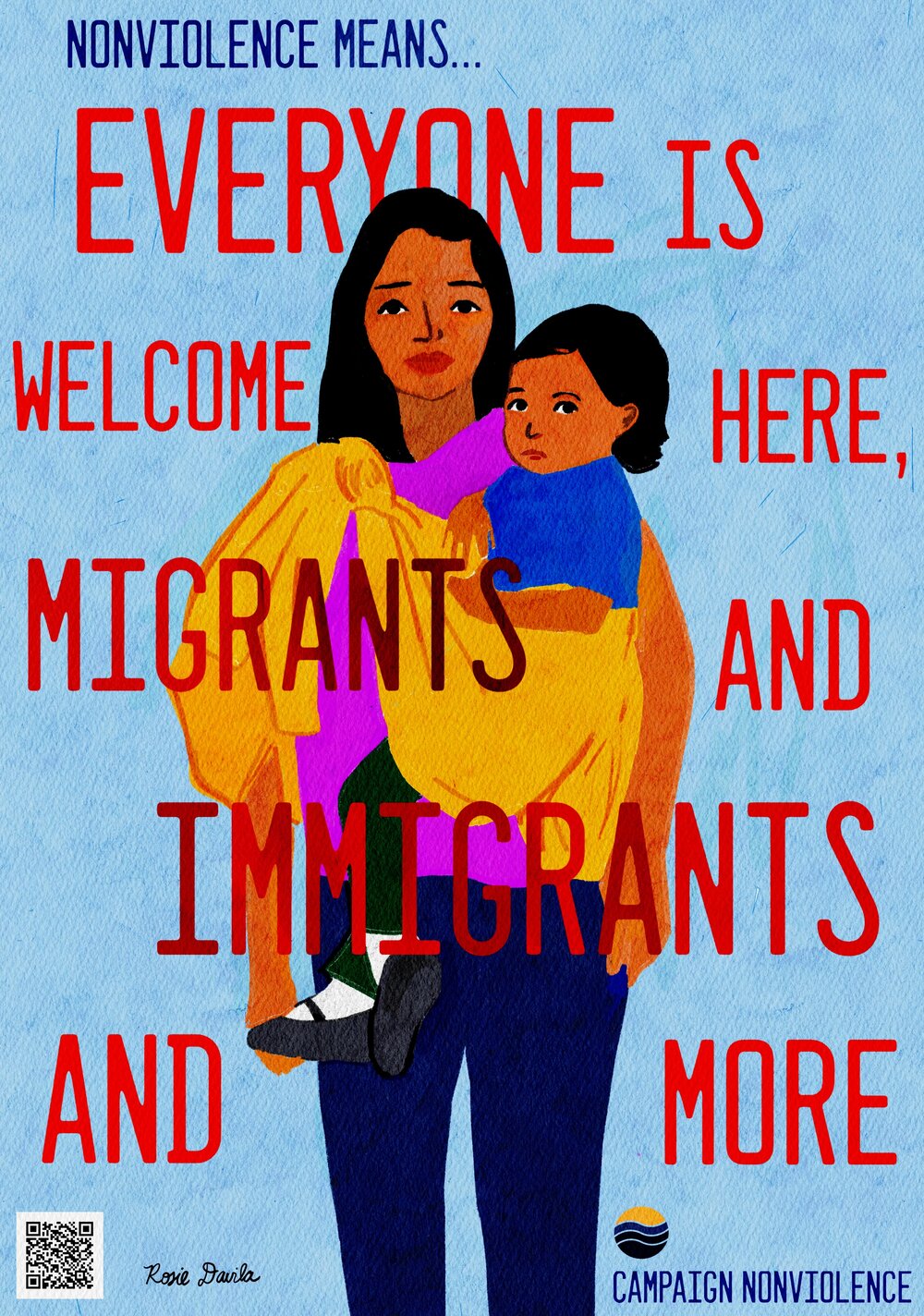
Everyone is welcome.
Policies that welcome and support migrants and immigrants are a form of structural nonviolence. They stand in contrast to discriminatory immigration policies that are forms of structural violence. Exclusion, bias, racism, discrimination, and stereotypes are all part of how the culture of violence causes harm. In a culture of nonviolence, we actively cultivate a welcoming, respectful approach to diversity, migrants, immigrants, refugees, and asylum seekers. In the face of discriminatory or cruel policies, we organize actively to stop raids or deportations. We prioritize human rights and safety for all (not just for some). We offer sanctuary and shelter. We make sure our immigration policies are welcoming and open to all. We create programs in our communities that help newcomers feel appreciated and included in their new homes.
Download this poster
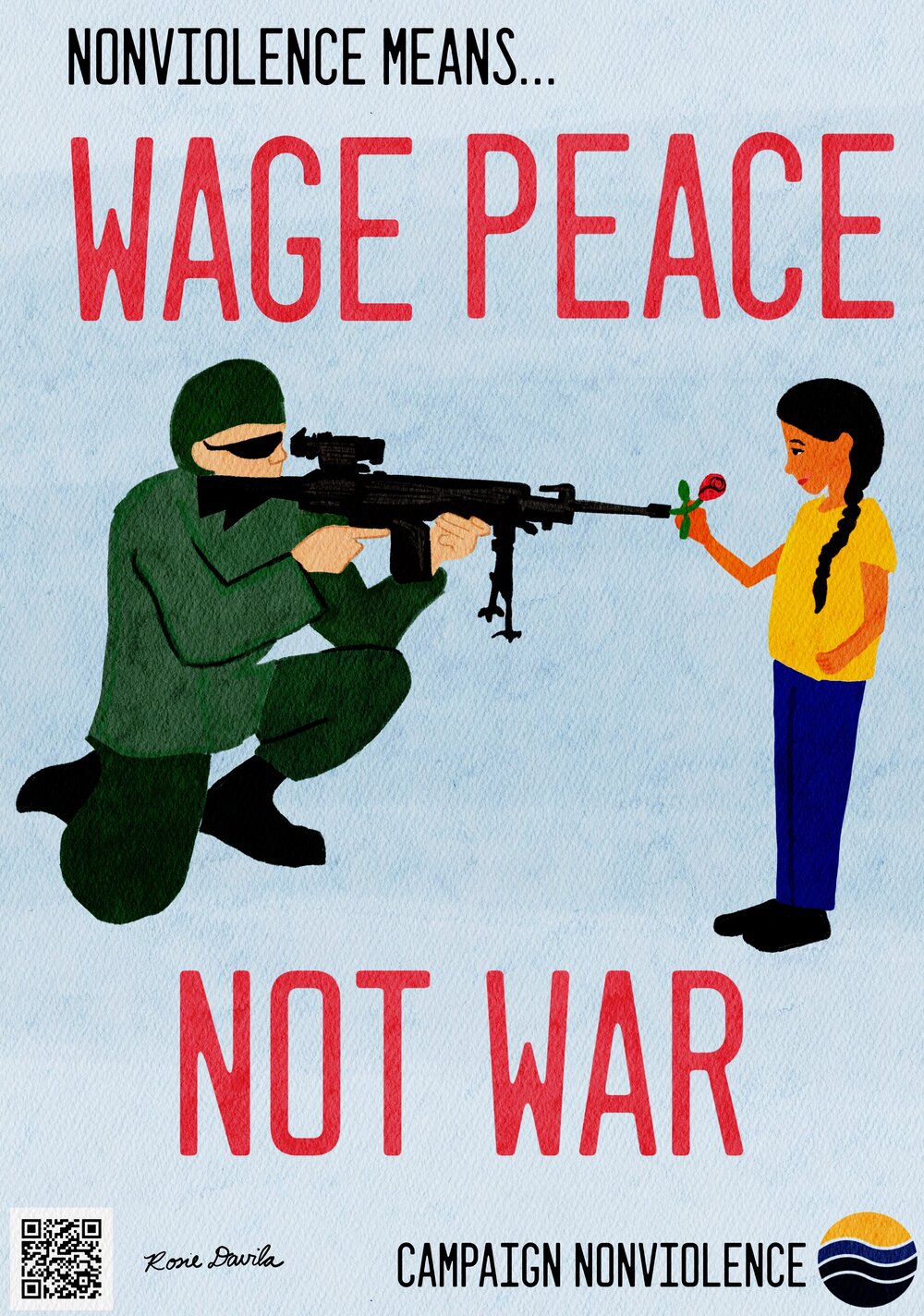
Wage Peace
What would our world look like if we dedicated the time, money, and resources we spend on war to waging peace, instead? Nonviolence means that we oppose war and militarism. We strive to redirect the wasteful, destructive spending on weapons and military contractors to programs that reduce poverty, raise human dignity, protect the Earth, build peace, and advance social justice both domestically and abroad. We support efforts to resolve disputes peacefully, and justly. We train in the uses of nonviolence and nonviolent solutions as an alternative to addressing conflicts with violence and war. We actively fund and participate in peacebuilding efforts.
From unarmed peacekeeping to peacebuilding, there are hundreds of practices for resolving conflicts without violence and warfare. In the last few decades, nonviolent revolution has replaced numerous civil wars and won independence without firing a shot. It’s also twice as effective as violent means. Imagine a world where entire nations trained in nonviolent struggle, drilling in how to organize a boycott, strike, or blockade. Some nations, like Lithuania, have even crafted plans of civilian-based defense built on nonviolent resistance. Peace is not merely the absence of war. It is the presence of all the practices and policies that help humanity deal with conflict in just and fair ways. Nonviolence means that we use them.
Download this poster
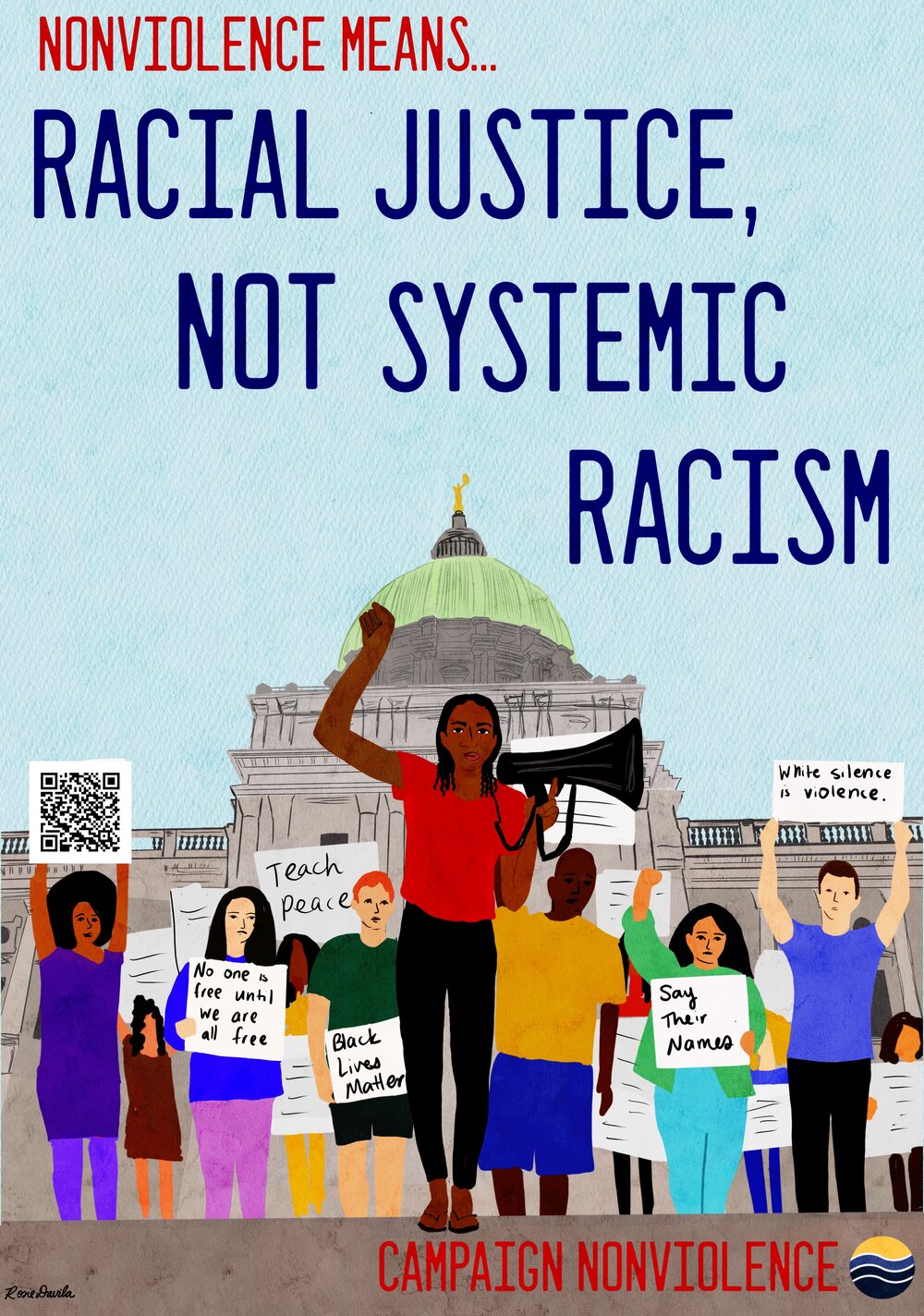
Racial Justice
Racism is violence. Whether it is overt and physical (like lynchings and police brutality) or less visible and systemic (like disproportionate health outcomes or underfunded schools), racism is a form of violence. At a time when the word “nonviolence” is misused by power holders to control the righteous outrage of people of color, our definition of nonviolence must include challenging all those who uphold and support structures and systems of racism. Nonviolence means taking a clear look at ourselves, our choices, the organizations and institutions we work with, and the communities to which we belong, and striving to end racism in all its forms. It means holding powerholders accountable and participating in movements for racial justice, as organizers, participants, or allies.
Nonviolence means supporting the solutions proposed by people of color and actively working to help them succeed. Nonviolence is embodied in demands to #DefundPolice and fund social responders and mental health services. Nonviolence is found in efforts to deconstruct the mass incarceration system and the school-to-prison pipeline, and implement restorative justice in its place. Reparations are a form of nonviolence. Anti-racist trainings are a form of nonviolence. Nonviolence requires action, not passivity. It demands that the violence of systemic, structural, physical, cultural, and environmental racism is dismantled. It requires us to celebrate and support the alternatives and solutions proposed by people of color, until the rights and dignity of people of all races are equally upheld and honored.
Download this poster
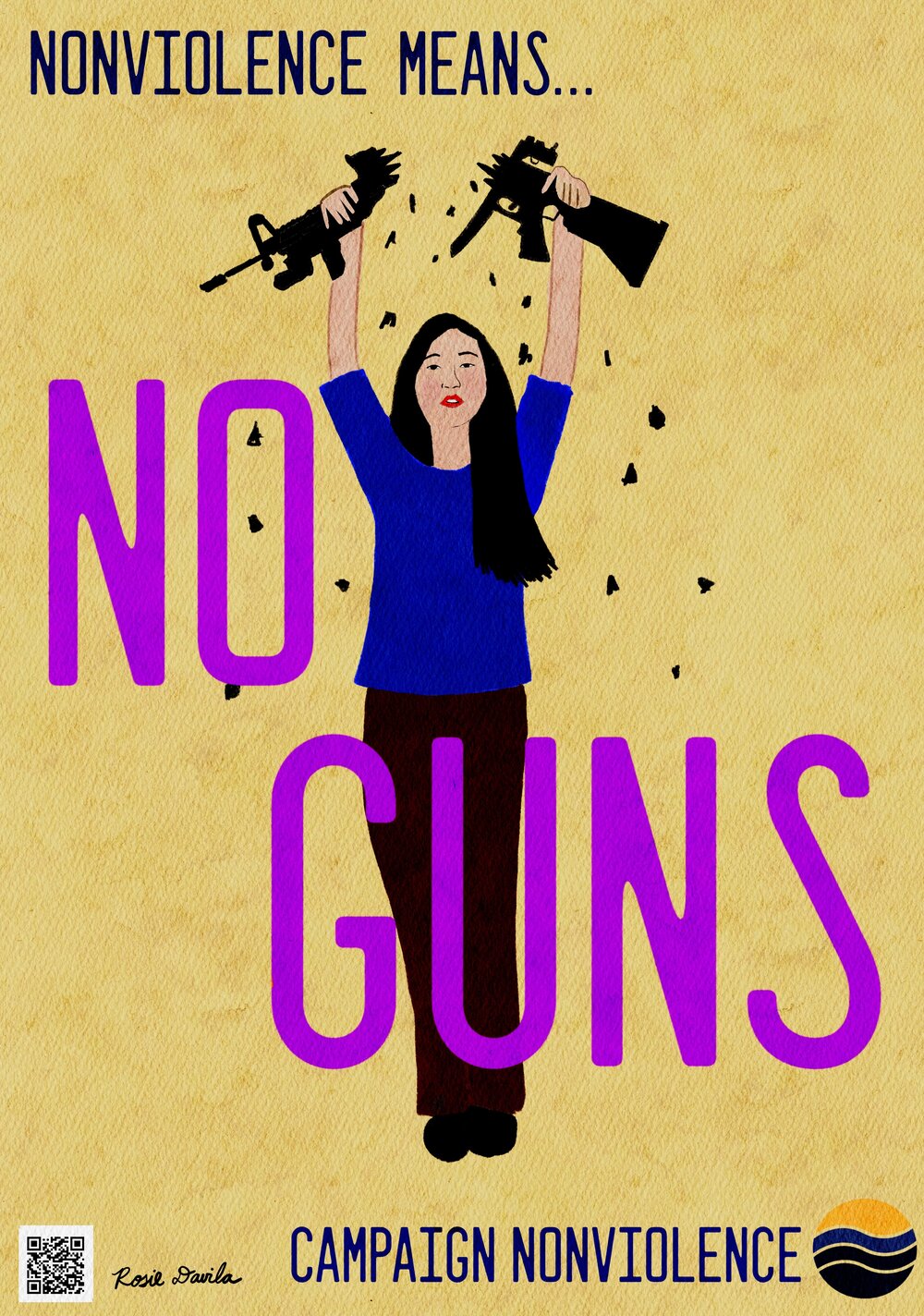
No Guns
Can we even imagine a world without guns? From handguns to assault rifles, there are hundreds of millions of guns in our world. Most have only one purpose: to kill another human being. In 2021 alone, there were 18.8 million guns sold in the United States. Trillions of dollars are exchanged in weapons sales each year. The profits are immense - and the weapons industry spends millions in lobbyists and public relations trying to protect that money. Meanwhile, people buy guns for protection and security, often driven by an underlying sense of fear. Paradoxically, the presence of more guns in society doesn’t make us safer. It makes us more likely to be killed by a gun. That’s why, to successfully get rid of guns, we need to do more than just ban them. We also need to build a sense of security in community, defense rooted in peace, and peace rooted in justice. It’s a big challenge, but it’s needed if we want to live in a nonviolent world.
Download this poster

Respect the planet.
We can’t bomb our way out of the climate crisis. It’s time to defund war and violence, and invest in peace, sustainability, and nonviolence. Instead of building weapons, we need to build windmills (or solar panels). Rather than pouring trillions of dollars into the US military (the single-largest polluter on the planet), we need to fund climate solutions that help everyone live more safely. National security can only truly be found in nonviolent means of equality, justice, peace, and sustainability. Nonviolence means shifting how humanity relates to the Earth, ending pollution and fossil fuel use, resource extraction, toxic waste, and destruction of ecosystems. Nonviolence also means ending wars (for oil or anything else) and stopping militarism. Nonviolence means a massive change from a culture of violence to a culture that offers dignity and respect to both people and planet.
Download this poster
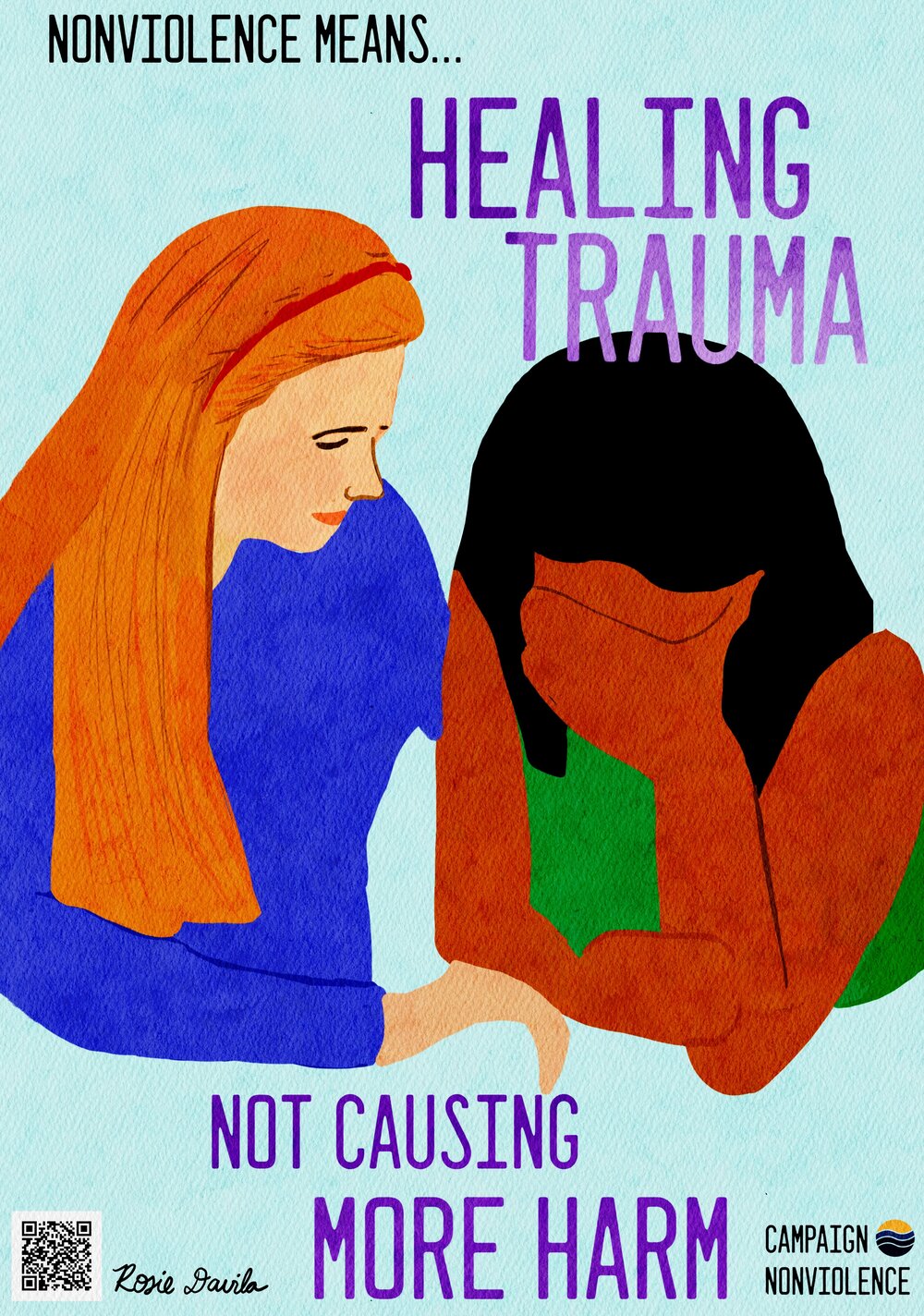
Heal Trauma
Nonviolence isn’t just the absence of violence; it’s the presence of healing, transformation, and justice. Trauma-informed approaches help people in workplaces, schools, and communities avoid compounding previous trauma with more harm. Dealing with trauma requires sensitivity, care and awareness. It requires us to shift the culture of institutions and organizations to dismantle practices that leave people traumatized. Many aspects of “everyday” life cause emotional, psychological, and cultural harm. On top of that, historical injustices have compounded into intergenerational trauma. Nonviolence means actively changing practices and approaches to help people heal trauma—past, present, and future.
Download this poster
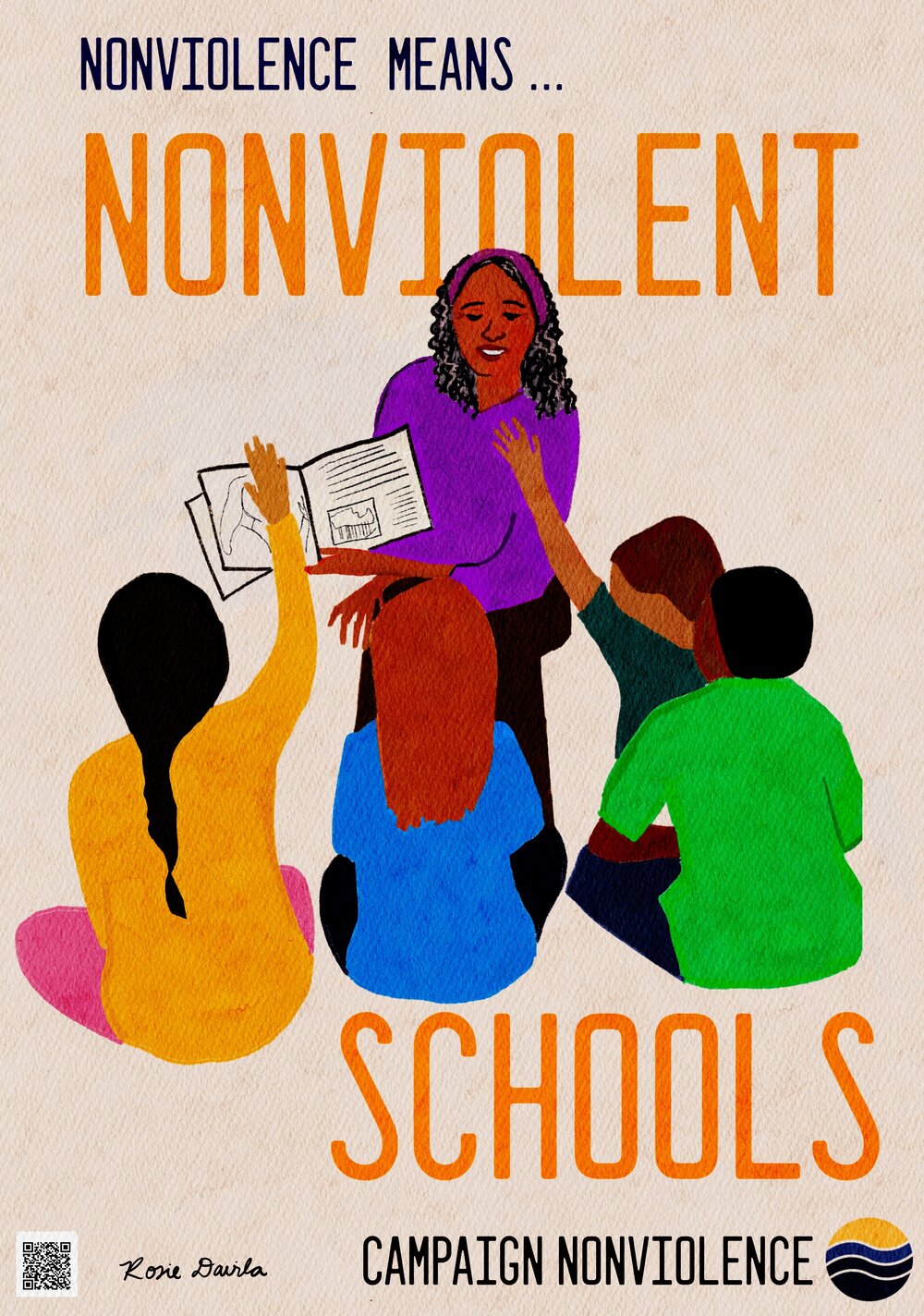
Nonviolent Schools
In Nonviolent Schools, students are taught all aspects of nonviolence. They learn how to practice nonviolence toward themselves, all others, and the whole world. Students study conflict skills along with math. Teachers share stories about nonviolent history and how they’ve won rights, freedoms, and protections for people around the world using tools like protests, boycotts, and strikes. Student-painted murals adorn the walls, showing nonviolent actions or campaigns, practices or skills. Restorative justice is used with students and staff. The best news? Nonviolent Schools already exist! In the United States, the first nonviolent public school was created at Broadrock Elementary School in Rhode Island. Now the program is expanding across the country. Learn more here.
Download this poster

Every person belongs.
Nonviolence asks that we stand up for the well-being of all. We know violence isn’t just physical. It can also take the form of social violence or cultural violence (such as sexism and homophobia) and the ways people are discriminated against because of their sexuality or gender. Nonviolence means creating a culture that accepts and embraces people as they are. It means cultivating attitudes of inclusion and welcoming. It means seeking to understand and appreciate instead of judge and shame. Nonviolence also requires us to actively support movements to deconstruct the systemic and structural barriers to equality and equity, including wage disparities, discriminatory health policies, legal obstructions to marriage and equal rights, and much more. A nonviolent world is one where every person feels like they belong.
Download this poster
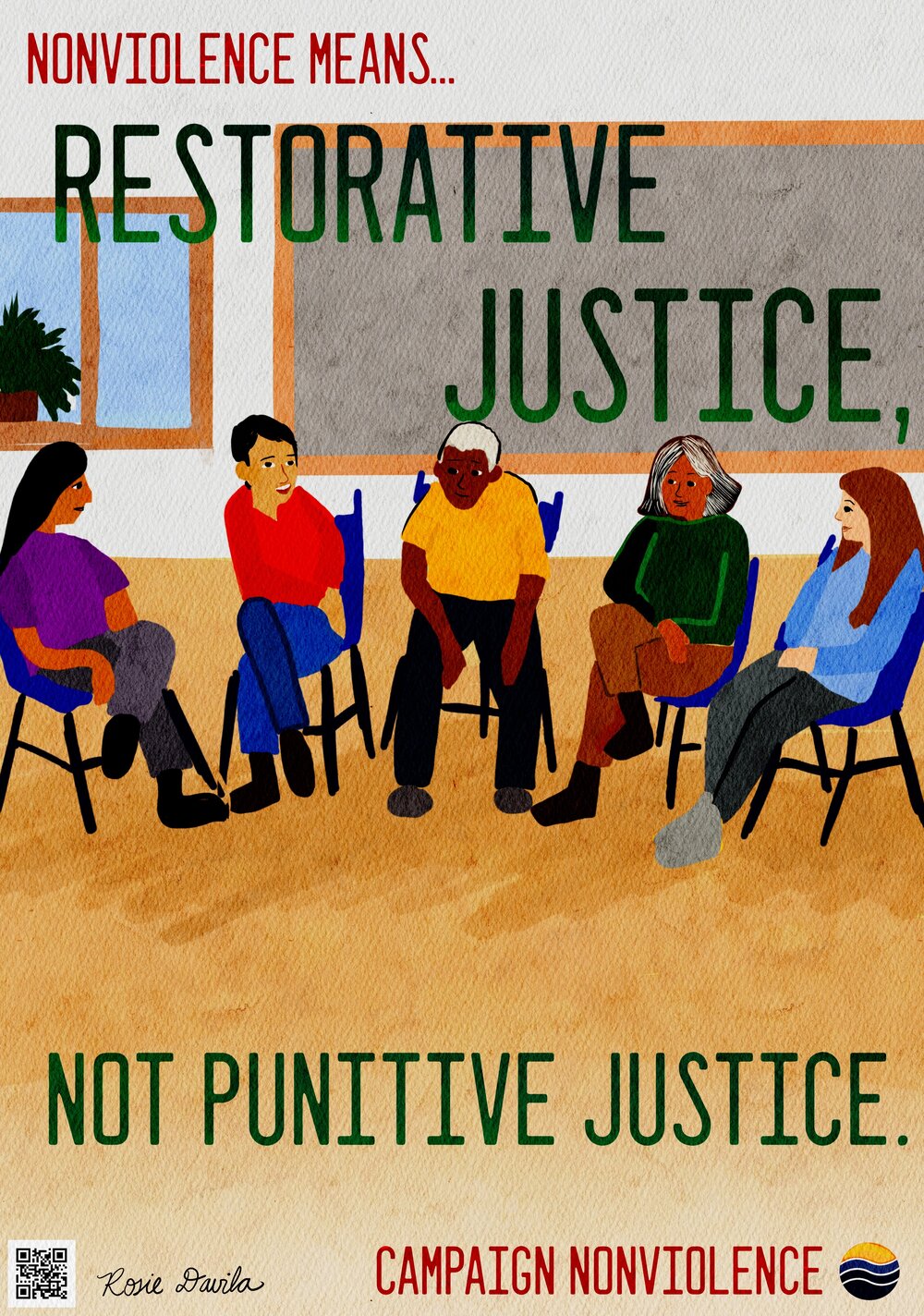
Restorative Justice
Restorative justice is an approach to healing harm and holding people accountable that comes from Indigenous traditions. It is increasingly being used as a way of intervening in the mass incarceration system and the school-to-prison pipeline. Unlike punitive justice, which tries to stop crime by punishing people (a system that often fails to prevent wrongdoing or stop it from happening again), restorative justice uses a discussion-based process to find out what happened, who was harmed, how that harm can be addressed, and how it can be prevented from happening again. It is a process of justice that is rooted in principles of nonviolence for everyone involved. You can learn more by watching this short video from the Metta Center For Nonviolence.
Download this poster

Housing for All and Living Wages
Nonviolence is a world where every person has shelter, food on the table, drinkable water, and enough resources to access the basic necessities of life. Unaffordable rents, evictions, homelessness, low wages, and exploitation of workers are all forms of violence. In the United States, we have enough houses for everyone, but millions of people, including families, are forced to live in tents on the streets. They face hunger, lack of healthcare, the potential of police harassment, the dangers of assault, social shunning, and exposure to extreme heat or cold. Nonviolence means that we end homelessness, guarantee housing for all, and work to make rents or mortgages affordable. Nonviolence also means taking care of people, honoring the work they do, and ensuring that they have enough for a good life. For hundreds of years, the global labor movement has been using strikes and boycotts to insist that workers are respected, that their wages are fair and cover the cost of living, and that their workloads are not destructive of the body or spirit. Living wages are an essential component of economic justice. They are a tool for making sure each person not only survives, but also feels fully supported in our society. With housing for all and living wages, nonviolence can be woven into the fabric of life, built into our economic systems, and offer each and every single person their basic human rights.
Download this poster

Defund Police, Fund Community Safety Teams
The rallying cry to #defundpolice doesn’t mean ignoring the need for public safety. It means acknowledging that militarized police do not keep our communities safe. Viable alternatives, rooted in nonviolent de-escalation and unarmed peacekeeping, exist and are at work in dozens of cities across the country. From neighborhood violence reduction teams to unarmed peace teams, there are a number of ways to build community safety without resorting to armed police. Many places are redirecting funds into trained social responders, mental health teams, and community safety teams. Investing in these programs and building up our capacity to solve our problems and conflicts without violence is a key component of addressing systemic racism and police brutality. It is also an important part of creating a culture of active nonviolence.
Download this poster
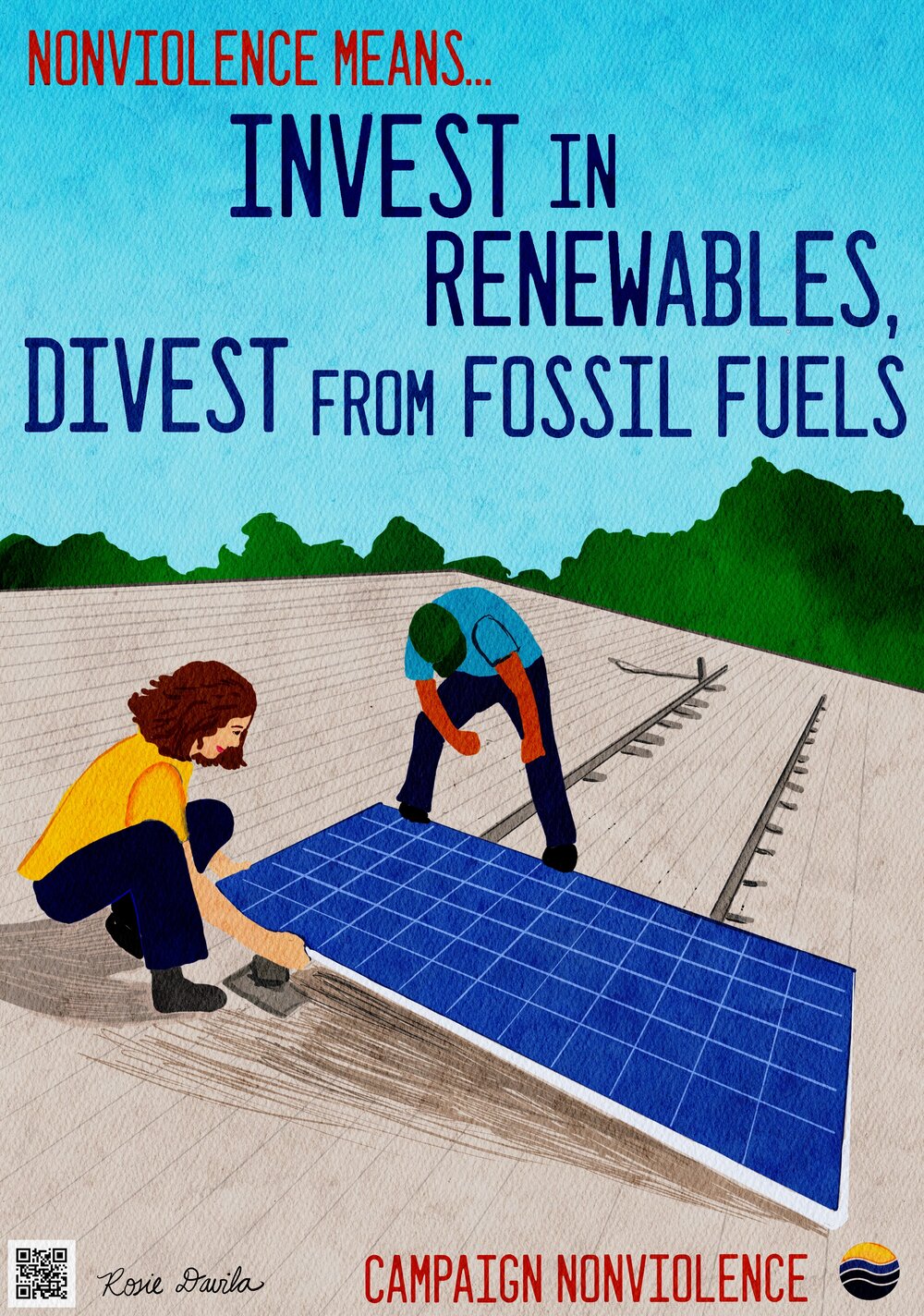
Invest in Renewables, Divest from Fossil Fuels
Practicing nonviolence toward the Earth and shifting away from the highly-destructive, climate-crisis causing fossil fuels is one of the most critical shifts for humanity to make in the next decade. By moving our money out of fossil fuels and into renewable energy, we can escalate the transition. Divestment campaigns pressure universities, city funds, major wealth holders, retirement and investment companies, and more to stop financing the massive destruction of the Earth. We can practice nonviolence by making sure our money is supporting life-affirming, sustainable, regenerative, and renewable energy.
Download this poster

Ending Gun Violence
From suicides to mass shootings to militarized policing, gun violence is an epidemic. In 2018, there were roughly 48,000 deaths by guns in the United States, including 24,432 suicides. Ending gun violence requires limiting access to guns and dealing with the underlying reasons why people pick up weapons in the first place. We need to establish a different kind of safety and security rooted in nonviolence. It can be done. Groups like Nonviolent Peaceforce, or the DC, Portland and Meta Peace Teams already offer unarmed peacekeeping at protests, festivals, and in conflict zones. Community safety initiatives and social responder programs offer alternatives to armed police in numerous situations. The more we build up these alternatives, the less reliant on guns our communities are. It may be hard to imagine a world without guns, but such a world is possible. Nonviolence means having the vision and courage to work for such a world.
Download this poster.
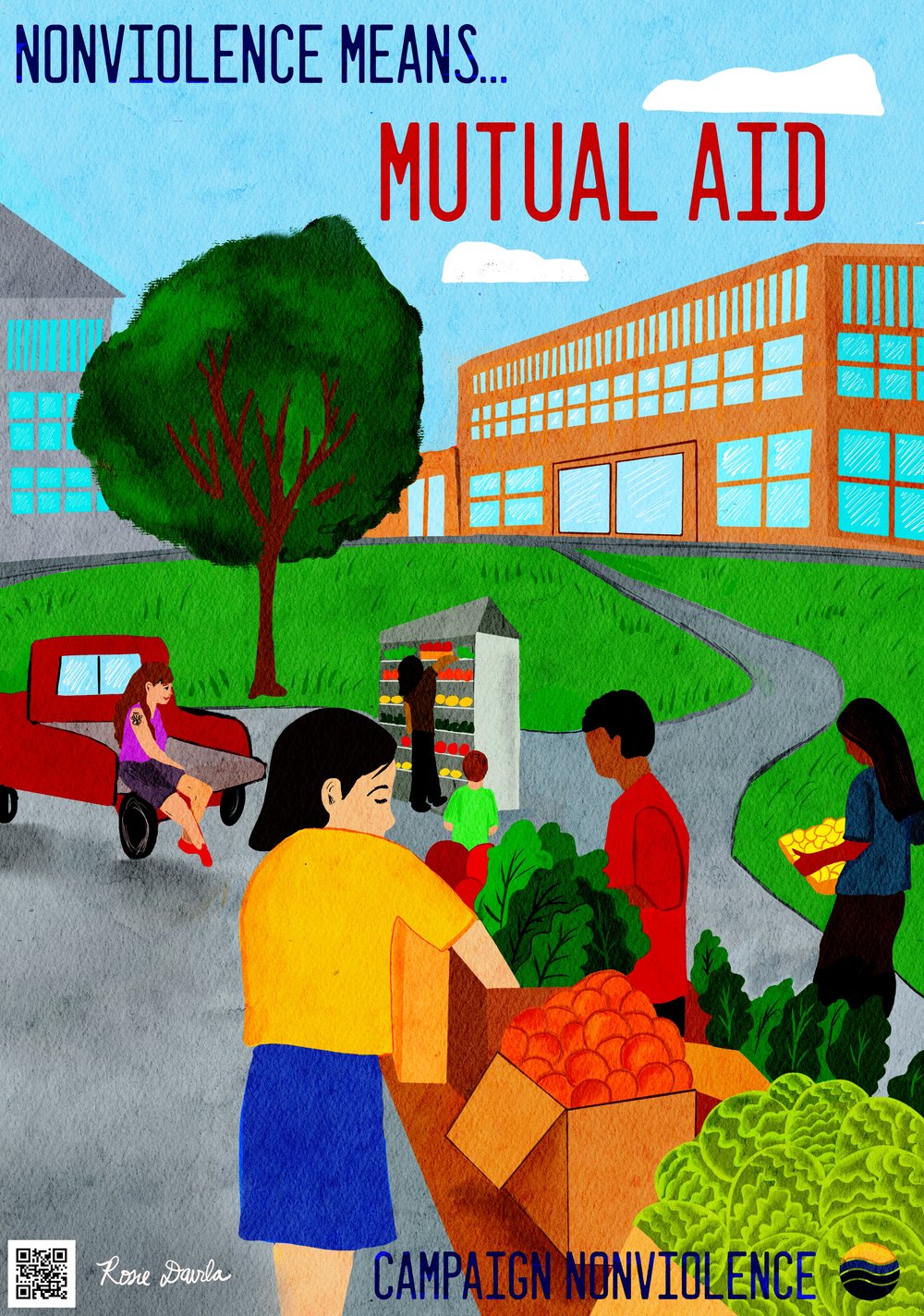
Mutual Aid
Emphasizing solidarity rather than charity, mutual aid networks are how people stand together with other people to meet basic needs. A network might provide food, medical care, housing, disaster relief, direct action support, tools, knowledge, and more. In the wake of the COVID-19 pandemic, these networks erupted across the United States, helping displaced university students move back home, supporting workers who got sick, assisting families threatened by eviction, handing out masks and hand sanitizer, and more. Mutual aid is about building new social bonds where people give what they can and get what they need, outside of unjust or unequal systems. It is the spirit of the action as much as the deed that makes mutual aid a revolutionary act and a cornerstone of nonviolent resistance.
Download this poster.

Protecting Our Watershed
Water is life. It’s sacred. We can’t live without it. Yet, our water and watersheds are increasingly endangered. Oil and gas extraction threatens vast areas with contamination. Places like Flint, MI, have been without safe drinking water for years. Droughts are causing scarcity in arid regions. Cities are sucking ecosystems to the bone. Poisoning or drying up life-giving water is an act of violence. Therefore, nonviolence means that we will keep the water healthy and abundant. We will share the water with the ecosystem and our fellow human beings. We will use it wisely and respectfully. We will conserve and protect it. We will support and join nonviolent movements (especially Indigenous-led campaigns) ensuring all the plants and animals have safe, healthy water.
Download this poster.
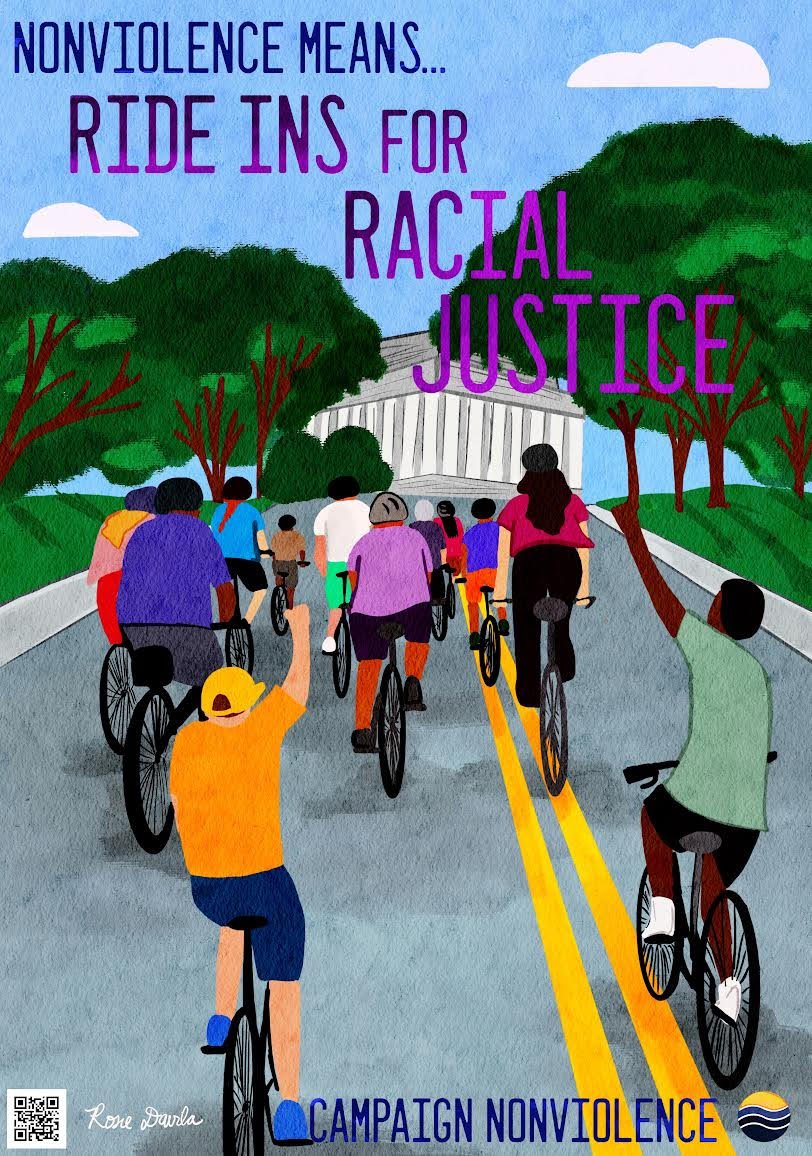
Bonus!
Here's a special poster for our Sept 28th Ride-Ins For Racial Justice.